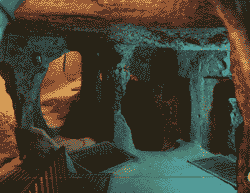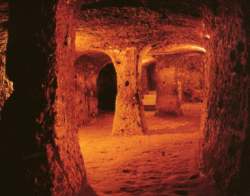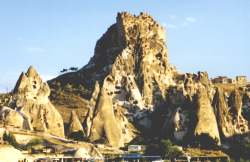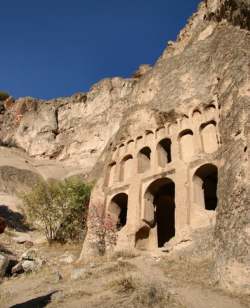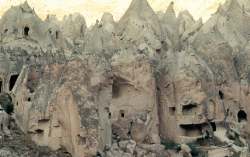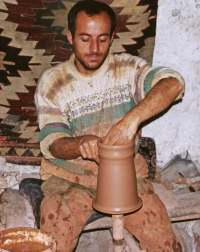Let's start to Cappadocia tour. The region known in ancient times as Cappadocia is the setting for some of nature's most bizarre wonders. It incorporates the provinces of Aksaray, Nevsehir, Nigde, Kayseri and Kirsehir. For most people the name Cappadocia suggest the towns and vicinities of Uchisar, Goreme, Avanos, Urgup, Derinkuyu, Kaymakli and Ihlara where in the course of millions of years, the land has been shaped into fantastic forms. "Fairy Chimneys" that seem haunted, and cities and houses of workship that extend many meters deep into the earth are all enveloped in an atmosphere that is ethereal and unworldly. Get ready now to take a brief journey into the Cappadocian region, where Mother Nature painstakinly worked miracles that defy the imagination and where the living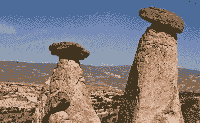 elements of history, culture, art, and society are inextricably linked. Millions of years ago three of the mountains in Cappadocia - Erciyes, Hasandag and Gulludag - were active volcanoes; indeed, this activity persisted intermittently at least into the Neolitic period if one considers the evidence of prehistoric paintings found on the walls of caves.
elements of history, culture, art, and society are inextricably linked. Millions of years ago three of the mountains in Cappadocia - Erciyes, Hasandag and Gulludag - were active volcanoes; indeed, this activity persisted intermittently at least into the Neolitic period if one considers the evidence of prehistoric paintings found on the walls of caves.
The eruptions appear to have begun in the Upper Miocene, less than 70 million years ago, in which lava began to flow from volcanoes submerged in Neogene lakes. The plateau of tuff formed from the materials discharged by the main volcanoes was continuously altered by the eruptions of smaller and less violent volcanoes.
From the Upper Pliocene onwards, these layers of tuff were exposed to eresion by rain and the waters of lakes and rivers, paticularly the Kizilirmak, resulting in what we see today. Foodwater pouring down the sides of valleys combined with strong winds tore away the softer volcanic rock exposing the harder variaties and resulting in the formations known an "fairy chimneys" of which there are several types in Cappadocia - conical pointed, columnar, mushroom-shaped and even a type that looks as if it's wearing a hat.
The Cappadocian region has been inhabited since prehistoric times. The evidence of this is plentiful, but the best examples of it have been unearthed at Kosk Hoyuk in Nigde and Asikli Hoyuk in Aksaray as well as in the Civeler cave in Nevsehir. During the Early Bronze Age, Cappadocia came under the influance af Assyrian civilization thanks to extensive trade, and it was during this period that writing was introduced. Researchers have turned up hoards of so - called "Cappadocian Tablets" - clay tablets inscribed with cuneiform writing whose texts speak of tax regulations interest rates, marriage contracts, trade disputes, and much else besides. The Hattis followed by the Hitites, Phrygians, Persians, Romans, Byzantines, Seljuks and Ottoman were all enchanted by the allure of Cappadocia and left the imprint of their own presence here.
Because of its location, Cappadocia was an extremely critical and strategic region. Important trade routes - including the illustrious Silk Road - traversed it both east and west and north and south. As a result of this heavy traffic, the region was a complex web of historical and cultural influences. Cappadocia was where different faiths and philosophies met and influenced one another.
Cappadocia's trade and resources were tempting prizes and the region was frequently ivaded, raided and looted. To protect themselves from such depredations, the local inhabitants took to living in the region's caverns and grottos whose entrances could be concealed so as not to be noticed by trouble making outsiders. Since it might be necessary to lie low for extented periods of time, these troglodytic dwellings eventually became subterranean cities that included sources of water, places to store food, wineries and temples. Some of them date back to before the Christian era.
In the early years of the first millennium, groups of Christians fleeing from Roman persecution began moving into the inaccessible wilds of Cappadocia seeking refuge. One group, which arrived here from Jerusalem via Antioch and Caesarea in the second century, settled down in the area now called Derinkuyu. Finding the soft volcanic tuff easy to carve, they began expanding the natural caves, linking them together and in addition to dwellings, creating chapels, churches and whole monastereies as they shaped with their hearts, minds and hands the peace and security that they so desperately sought.
There are said to be more than a thousand churches and chapels in Cappadocia. The variety and artistry of their architecture, layout and decoration are fascinating and amazing. The whole panoply of religious architecture - basilicas with single, double or triple naves, cruciform plans, vestibules, asisles, apses, domes, columns, pillars, and more - can be found in these churches and all of it has been hollowed out of the stone. Many of the churches are decorated with painstakingly executed frescoes. The monumental task of restoring, repairing and maintaining these churches and underground ities goes on continuously even while they receive thousands of visitors a year.
Don't forget to join balloon tour and go to Ihlara Valley on Cappadocia Tour. In the province of Nigde, frescoed churches and dwellings carved into the cliffs extend from Ihlara walley which is 40 km from Aksaray, as far as the town of Selime. Some of these structures can be dated back to as early as the 4th century. Among the many sights worth seeing are the Egritas, Agacalti, Kokar, Yilanli, Purenli and Sivisli churches.
The splendid scene of the town of Uchisar, seven kilometers from Nevsehir, has an appeal that is irresistible. From the heights of the Uchisar citadel, you have a magnificent and unrivalled view of the whole region.
We arrive at the "belief centers", where the air thick with an enigmatic nimbus. Goreme and its environs, located ten kilometers from Nevsehir, are thought to have been used as a necropolis during Roman times by the inhabitants of Venessa (Avanos). The churches of Durmus kadir, Yusuf Koc, El Nazar, Sakli, Meryem Ana and Kiliclar cast a spellbinding effect upon visitors. The Goreme Open Air Museum is where the "educational system that unified all the ideas of Christianity" of St Basil the great and his brothers was born. In the Tokali Church, the Convent of Monks and Nuns, the Elmali, Yilanli, Karanlik and Carikli churches the architectural details and frescoes seem as alive today as when they were new.
Cavusin, located two kilometers from Goreme, is one of the oldest inhabited places in the region. The fresco scenes in the Cavusin church are distinctive because of their unusual compositions.
Kilise, Pasabaglari and the Cell of St Simeon are among the most impressive sites at Zelve.
In Urgup, 20 kilometers east of Nevsehir, the St Theodora and Pancarlik churches are elaborately decorated with religious art.
In the town of Ortahisar, six kilometers from Urgup, the most impressive sight is the once strategically important Ortahisar citadel. Fine examples of Cappadocia's vernacular architecture cluster thickly around the base of the citadel. Also, worth seeing is the Uzumlu church, on the western side.
Six kilometers south of Urgup is Mustafapasa (Sinasos) a town justifiably famous for its splendid stone works. The Chapel of St Basil is decorated with motifs reflecting the Iconoclastic system of thought.
The town of tatlarin is located ten kilometers north of Acigol. The tatlarin church is graced with well preserved frescoes.
Twenty kilometers from Nevsehir are the Aciksaray ruins and the Church of St John in the town of Gulsehir.
The karabas, Kubbeli and St Barbara (tahtali Kilise) churches located in Soganli Valley in Kayseri province's Yesilhisar county are paticularly important because of their architectural styles and their detailed fresco scenes.
The Eski Gumus church located in the town of Gumusler, eight kilometers northeast of Nigde, is a cliff monastery church and is decorated with fresco scenes that are extremely detailed and delicately executed. In addition to this, the underground cities of Kavlaktepe, Fertek, Konakli, Baglama, Kayirli, yesiltepe and Aktas Andabalis churches are sites worth visiting that are of great importance to Christians. Ancient city of Tyana (Roman period) is worth seeing.
Built into the Ucayak, derefakili, Aflak and Aksakli caves in Kirsehir province are historic places of worship that are important for Christianity.
Mention has already been made of the cappadocia region's "underground cities" places that are as amazing as they are fascinating. There are many of them but the most extraordinary are the ones at Kaymakli, Derinkuyu, Mazi, Ozkonak and Tatlarin. In Kirsehir province, the underground cities of Mucur, Dulkadirli, Inlimurat and Kumbetalti are also quite impressive in their extent and layout. These were all used as shelters for great lengths of time and having undergone restoration work, they are now open to visitors.





















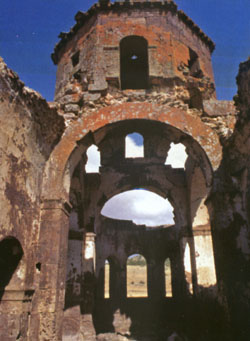

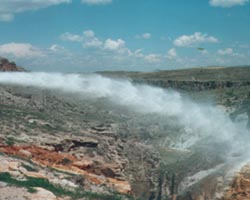

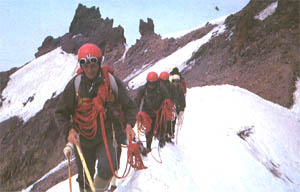








 elements of history, culture, art, and society are inextricably linked. Millions of years ago three of the mountains in Cappadocia - Erciyes, Hasandag and Gulludag - were active volcanoes; indeed, this activity persisted intermittently at least into the Neolitic period if one considers the evidence of prehistoric paintings found on the walls of caves.
elements of history, culture, art, and society are inextricably linked. Millions of years ago three of the mountains in Cappadocia - Erciyes, Hasandag and Gulludag - were active volcanoes; indeed, this activity persisted intermittently at least into the Neolitic period if one considers the evidence of prehistoric paintings found on the walls of caves.